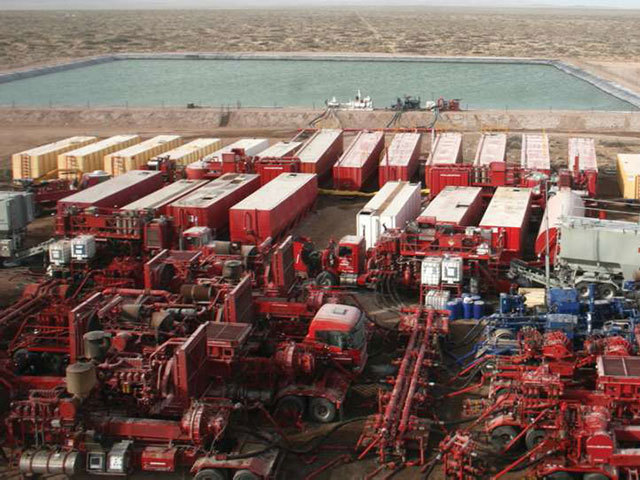
The insurance protecting shale drillers against plummeting prices has become so crucial that for one company, SandRidge Energy Inc., payments from the hedges accounted for a stunning 64 percent of first-quarter revenue.
Now the safety net is going away.
The insurance that producers bought before the collapse in oil — much of which guaranteed minimum prices of $90 a barrel or more — is expiring. As they do, investors are left to wonder how these companies will make up the $3.7 billion the hedges earned them in the first quarter after crude sunk below $60 from a peak of $107 in mid-2014.
“A year ago, you could hedge at $85 to $90, and now it’s in the low $60s,” said Chris Lang, a senior vice president with Asset Risk Management, a hedging adviser for more than 100 exploration and production companies. “Next year it’s really going to come to a head.”
The hedges staved off an acute shortage of cash for shale companies and helped keep lenders from cutting credit lines, many of which are up for renewal in October. With drillers burdened by interest payments on $235 billion of debt, $89 billion of it high-yield, a U.S. regulator has warned banks to beware of the “emerging risk” of lending to energy companies.
Payments from hedges accounted for at least 15 percent of first-quarter revenue at 30 of the 62 oil and gas companies in the Bloomberg Intelligence North America Exploration and Production Index. Revenue, already down 37 percent in the last year, will fall further as drillers cash out contracts that paid $90 a barrel even when oil fell below $44.
Increased Efficiency
West Texas Intermediate for August delivery added 4 cents to $57 a barrel in electronic trading on the New York Mercantile Exchange at 11:29 a.m. Singapore time.
Hedges purchased from banks or other traders allow drillers to lock in a sale price. Some guarantee a specific value. Others ensure a minimum payment regardless of how much the market moves, but require the oil company to pay some of it back if the price exceeds a certain threshold.
SandRidge, the Oklahoma City-based producer, had about 90 percent of its oil and natural gas liquids output hedged in early 2015, according to a regulatory filing. Next year, the hedges cover less than a third. SandRidge stock traded yesterday at 85 cents, down 88 percent in the last year. More than $3 billion of its bonds are trading at 62 cents on the dollar or less.
Jeff Wilson, a spokesman for the company, said declining well costs and increased efficiency are helping SandRidge achieve returns comparable to what the company made at higher prices. SandRidge issued $1.25 billion in bonds last month, which gives the company the liquidity it needs, Wilson said.
Buy Time
For SandRidge and other drillers, the hedges, required by some lenders, gave them enough time to cut spending. Costs in shale fields have fallen by 20 to 30 percent and productivity has increased as producers moved rigs to the most prolific regions. Producers were able to raise about $44 billion in equity and debt in the first quarter, according to UBS AG.
“That postponed the day of reckoning,” said Carl Tricoli, co-founder of private-equity firm Denham Capital Management.
At Goodrich Petroleum Corp., hedges accounted for 35 percent of revenue in the first three months of 2015. Most of its insurance runs out at the end of the year, company records show.
Daniel Jenkins, director of corporate planning and investor relations for Goodrich in Houston, didn’t return calls seeking comment.
Supportive Lenders
Oasis Petroleum Inc., one of the most active drillers in North Dakota’s Bakken shale, received almost $91 a barrel for 19,000 barrels a day. That accounts for more than 40 percent of its daily production and is the biggest piece of its hedging program. At the end of June, the guaranteed price drops to $77, company records show. By January, the company will have just 2,000 barrels a day hedged at $65 a barrel.
Richard Robuck, vice president of finance for Oasis, said the company’s hedges worked perfectly. The cash infusion gave Oasis the time it needed to cut back from 16 drilling rigs to four, which will allow the company to spend less than it brings in, even at lower prices. Oasis also has a “very supportive lender group,” plenty of room on its credit line and a plan to add new hedges for next year, he said.
“There’s a chance prices fall, and there’s a chance they go up,” Robuck said. “It’s the oil business. That’s why we hedge.”
Forecasters including Citigroup Inc. and Bank of America Corp. see U.S. crude falling further in the final six months of the year. UBS predicts prices will slide as low as $50 a barrel.
Regulator Scrutiny
With oil prices down 45 percent in the past year, the industry is facing scrutiny from lenders and their regulator. Banks typically evaluate credit lines to oil and gas companies twice a year. The next time is October, and by then many of the drillers’ hedging contracts will have run out. The U.S. Office of the Comptroller of the Currency has expressed concern that the banks it supervises be more careful about lending to energy firms.
“Some companies are not nearly as well-hedged for 2016 as they were for this year,” said Omar Samji, a partner in law firm Jones Day’s energy practice. “They’re going to have a real cash-flow crunch.”